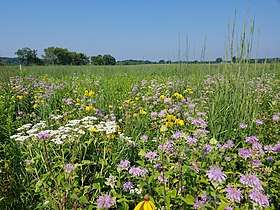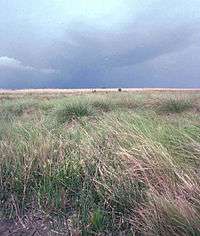Prairie restoration
Prairie restoration is a conservation effort to restore prairie lands that were destroyed due to industrial, agricultural, commercial, or residential development. For example, the U.S. state of Illinois alone once held over 35,000 square miles (91,000 km2) of prairie land and now just 3 square miles (7.8 km2) of that original prairie land is left.

Purpose
Ecologically, prairie restoration aids in conservation of earth's topsoil, which is often exposed to erosion from wind and rain when prairies are plowed under to make way for new commerce. Conversely, much more of the prairie lands have become the fertile fields on which cereal crops of corn, barley and wheat are grown.
Many prairie plants are also highly resistant to drought, temperature extremes, disease, and native insect pests. They are frequently used for xeriscaping projects in arid regions of the American West.
A restoration project of prairie lands can be large or small. A backyard prairie restoration will enrich soil, help with erosion and take up extra water in excessive rainfalls. Prairie flowers are attractive to native butterflies and other pollinators. On a larger scale, communities and corporations are creating areas of restored prairies which in turn will store organic carbon in the soil and help maintain the biodiversity of the 3000 plus species that count on the grasslands for food and shelter.
Types of plants
Some prominent tallgrass prairie grasses include big bluestem, indiangrass, and switchgrass. Midgrass and shortgrass species include little bluestem, side oats grama, and buffalograss. Many of the diverse prairie forbs (herbaceous, non-graminoid flowering plants) are structurally specialized to resist herbaceous grazers such as American bison. Some have hairy leaves that may help deter the cold and prevent excessive evaporation. Many of forbs contain secondary compounds that were discovered by indigenous peoples and are still used widely today. For example, purple coneflower (Echinacea purpurea or just Echinacea) is used as an herbal remedy for colds.
Early prairie restoration efforts tended to focus largely on a few dominant species, typically grasses, with little attention to seed source. With experience, later restorers have realized the importance of obtaining a broad mix of species and using local ecotype seed.[1]
Care of prairies
Fire is a big component to the success of grasslands, large or small. Controlled burns, with a permit, are recommended every 4–8 years (after two growth seasons) to burn away dead plants; prevent certain other plants from encroaching (such as trees) and release nutrients into the ground to encourage new growth. A much more wildlife habitat friendly alternative to burning every 4–8 years is to burn 1/4 to 1/8 of a tract every year. This will leave wildlife a home every year and still accomplish the task of burning. The Native Americans may also have used the burns to control pests such as ticks. If controlled burns are not possible, rotational mowing is recommended as a substitute.
One of the newer methods available is holistic management, which uses livestock as a substitute for the keystone species such as bison. This allows the rotational mowing to be done by animals which in turn mimics nature more closely. Holistic management also can use fire as a tool, but in a more limited way and in combination with the mowing done by animals.[2]
Prairie contributors
Some popular prairie restoration projects have been completed and maintained by conservation departments, such as Midewin National Tallgrass Prairie, located in Wilmington, Illinois. This restoration project is administered by the U.S. Department of Agriculture Forest Service and the Illinois Department of Natural Resources. It sits on part of the Joliet Army Ammunition Plant, specifically on an area once contaminated from TNT manufacturing. Since 1997, the project has opened some 15,000 acres (61 km2) of restored prairie to the public.
Another large restoration project finds its home on the ample area of Fermilab; a U.S. governmental atomic accelerator laboratory located in Batavia, Illinois. Fermilab's 6,800 acres (28 km2) sit a top fertile farmland and the prairie restoration project consists of approximately 1,000 acres (4.0 km2) of that. This project began in 1971 and continues today with the help of Fermilab employees and many community teachers, botanists and volunteers.
See also
- Buffalo Commons
- Holistic management
- Land rehabilitation
- Restoration ecology
References
- The Importance of using Local Ecotype Plant Material Archived 2010-09-23 at the Wayback Machine, Iowa Prairie Network
- Coughlin, Chrissy. "Allan Savory: How livestock can protect the land". GreenBiz. Retrieved 5 April 2013.
External links
- The Prairie Enthusiasts Grassland protection and restoration in the upper Midwest.
- Prairie Plains Resource Institute
- Prairie Parcel Restoration
- Prairies Forever
- Midewin National Tallgrass Prairie
- Fermilab Prairie Prairie at the Fermilab Accelerator at Batavia, IL
- Prairie Restorations, Inc.
- Citizens for Conservation A non-profit centered in Barrington, IL restoring prairie, savanna and wetland habitats.
- Sauk Prairie Conservation Alliance, located in central Wisconsin; instrumental in the rehabilitation of the Sauk Prairie on the Badger Army Ammunition Plant
- International Crane Foundation, restores prairies and other crane habitats.
- Youcanchangetheplanet.org - A non-profit organization dedicated to sustainable conservation and the rehabilitation of prairies, forests, and wetlands.
- American Prairie Foundation - A non-profit organization devoted to creating a prairie-based wildlife reserve in northeastern Montana.
- Missouri Prairie Foundation - A non-profit organization protecting native grasslands throughout the state of Missouri.
- Grand Prairie Friends - A non-profit organization dedicated to preserving and restoring prairies and forests in east-central Illinois, promoting an understanding and appreciation of natural resources.
